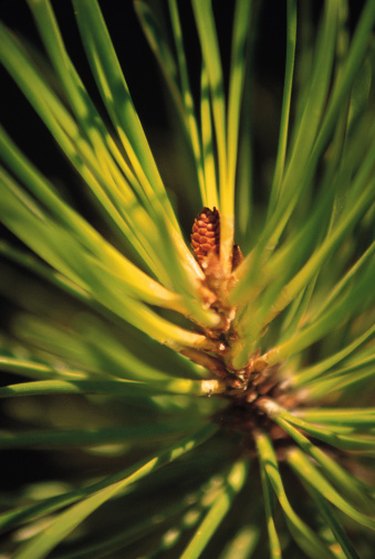
Pine trees are common in the northern areas of North America. Best suited for forests, pines are also common landscaping trees whether by design or the result of development, which may leave standing pines in place. They are also ornamental trees, particularly during winter holidays, and its cones and needles can be used for decorations as well. In addition to the tree's beauty and appealing fragrance, however, its needles can come with a sticky substance caused by disease or sap residue from the tree.
Sap
Video of the Day
Tree sap can flow through sapwood transport tissue, xylem and phloem, which produces carbon dioxide. Both varieties consist primarily of water, along with hormones and minerals. Xylem sap also contains nutrients for the tree, and phloem contains sugar. The combination of these elements makes sap sticky. Since the sap is contained in the tree, this isn't a problem unless the tree has any open wounds, which cause the sap to leak. Then, the sap can get on the pine needles.
Video of the Day
Infestation
Pine needles may also be covered in a sticky substance caused by disease and infestation, such as aphids, which are attracted to pine trees. According to the University of California's Department of Agriculture and Natural Resources, "Aphids are small, soft-bodied insects with long, slender mouth parts that they use to pierce stems, leaves, and other tender plant parts and suck out plant fluids." In addition to causing openings in pine trees which may cause sap to leak, the aphids themselves emit a sticky substance called honeydew.
Problems
Because pine trees are popular as landscaping trees, falling pine needles covered by sap or honeydew can cause problems for home and car owners. Common frustrations include sticky pine needles and substances on car roofs and windows, and clogged gutters. Inside, sticky pine needles from decorations can clog vacuum cleaners or can be difficult to remove when sweeping hardwood and tile floors.
Cleanup
For pine needles, in general, use a rubber broom or brush. The rubber will dig down deep in carpeting and cloth furniture and even on hard surfaces it will produce a static charge to attract the needles. Rubbing alcohol, an alcohol-based hand sanitizer or nail polish remover can all be used to remove sticky sap on hair, skin and clothing; follow by normal washing. For cars, take care with these products if used on paint; another option for sap removal on car paint is WD-40, which has mild solvent properties to break down sap and is safe for most car paints.